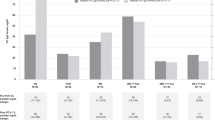Abstract
Cancer patients receiving chemotherapy are prone to develop infections that might postpone treatment and lead to complications. The aim of our study was to investigate whether a heterogeneous population of patients with solid tumors and malignant lymphoma undergoing chemotherapy would respond serologically to vaccination against influenza and pneumococcal disease. There are no established routines in oncology departments in Norway regarding vaccination of these patients. The study included 35 cancer patients with median age 53 yr (range 20–74) and 38 controls with median age 57 yr (range 43–75). The chemotherapy regimens used were mild or moderately immunosuppressive. After one vaccination, 25 patients (72%) and 34 controls (87%) were serologically protected against two or three influenza strains. A higher proportion of patients with solid tumors (81%) than lymphoma (38%) achieved protection. Age, months on chemotherapy, and curative versus palliative treatment did not influence responses to vaccination. After vaccination with a 23-valent polysaccharide vaccine against pneumococci, most patients and controls achieved protective serum levels of antibodies against the different serotypes, with the exception that fewer patients were protected against serotype 4. The responses in controls were, however, generally stronger to all serotypes. Tumor type did not influence this vaccination response. We conclude that our cancer patients achieved adequate responses to influenza virus and Streptococcus pneumoniae. These are not live vaccines and are therefore safe for immunocompromised patients. Routine vaccinations against influenza virus and Streptococcus pneumoniae should be considered in cancer patients undergoing mild to moderately immunosuppressive chemotherapy.
Similar content being viewed by others
References
Recommendations of the Advisory Committee on Immunization Practices (ACIP). (2000). Prevention and control of influenza. MMWR 49(RR03):1–38.
Pizzo, P. A. (1999). Fever in immunocompromized patients. N. Engl. J. Med. 341:893–900.
Ljungman, P., et al. (1995). Immunisations after bone marrow transplantation: results of a European survey and recommendations from the infectious diseases working party of the European Group for Blood and Marrow transplantation. Bone Marrow Transplant. 15:455–460.
Ljungman, P. (1999). Immunization of transplant recipients. Editorial Bone Marrow Transplant. 23:635–636.
Norwegian Institute of Public Health. (1998). Veiledning om vaksinasjon 1998 (Guidelines for Vaccination 1998) (H. Nøkleby, ed). Norwegian Institute of Public Health, Oslo.
Anderson, H., et al. (1994). Seroconversion after influenza vaccination in patients with lung cancer. Br. J. Cancer 80:219–222.
Brydak, L. B. and Calbecka, M. (1999). Immunogenicity of influenza vaccine in patients with hemato-oncological disorders. Leukemia Lymphoma 32:369–374.
Robertson, J. D., et al. (2000). Immunogenicity of vaccination against influenza, Streptococcus pneumoniae and Haemophilus influenza type B in patients with multiple myeloma. Br. J. Cancer 82:1261–1265.
Kempe, A., Hall, C. B., MacDonald, N. E. and Foye, H. R. (1989). Influenza in children with cancer. J. Pediatr. 115:33–39.
Ortbals, D. W., et al. (1977). Influenza immunization of adult patients with malignant diseases. Ann. Intern. Med. 87:552–557.
World Health Organization. (1982). Concepts and Procedures for Laboratory-Based Influenza Surveillance, ppB17-B35, World Health Organization, Geneva.
Aaberge, I. S., et al. (1996). Human antibody response to a pneumococcal vaccine in SCID-PBL-hu mice and simultaneously vaccinated human cell donors. Clin. Exp. Immunol. 105:12–17.
Stack, A. M., et al. (1998). Minimum protective serum concentrations of penumococcal anticapsular antibodies in infant rats. J. Infect. Dis. 177:986–990.
Salsbury, D. M. and Begg, N. T., ed. (1996). Department of Health Immunisation Against Infectious Disease, pp113–120, HMSO, London.
Chisholm, J. C., Devine, T., Charlett, A., Pinkerton, C. R. and Zambon, M. (2001). Response to influenza immunisation during treatment for cancer. Arch. Dis. Child. 84:496–500.
Schildt, R. A., Luedeke, D. W., Kasai, G., El-Beheri, S. and Laham, M. N. (1979). Antibody response to influenza immunization in adult patients with malignant disease. Cancer 44:1629–1635.
Clerici, M., et al. (1994). Multiple defects of T helper cell function in newly diagnosed patients with Hodgkin’s disease. Eur. J. Cancer 30:1464–1470.
Lo, W., et al. (1993). Antibody response to a two-dose influenza vaccine regimen in adult lymphoma patients on chemotherapy. Eur. J. Clin. Microbiol. Infect. Dis. 12:778–782.
Minutello, M., et al. (1999). Safety and immunogenecity of an inactivated subunit influenza virus vaccine combined with MF59 adjuvant emulsion in elderly subjects, immunised for three consecutive influenza seasons. Vaccine 17:99–104.
Pauksen, K., et al. (2000). Granulocyte-macrophage colony-stimulating factor as immunomodulating factor together with influenza vaccination in stem cell transplant patients. Clin. Infect. Dis. 30:342–348.
Babai, I., et al. (2001). A novel liposomal influenza vaccine (INFLUSOME-VAC) containing hemagglutinin-neuramidase and IL-2 or GM-CSF induces protective anti-neuraminidase antibodies cross-reacting with a wide spectrum of influenza A viral strains. Vaccine 20(3–4):505–515.
Neirynck, S., et al. (1999). A universal influenza A vaccine based on the extracellular domain of the M2 protein. Nat. Med. 5:1157–1163.
Sankilampi, U., Honkanen, P. O., Bloigu, A., Herva, E. and Leinonen, M. (1996). Antibody response to pneumococcal capsular polysaccharide vaccine in the elderly. J. Infect. Dis. 173:387–393.
Rubins, J. B., Alter, M., Loch, J. and Janoff, E. N. (1999). Determination of antibody responses of elderly to all 23 capsular polysaccharides after pneumococcal vaccination. Infect. Immun. 67:6979–5984.
Hartkamp, A., Mulder, A. H. L., Rijkers, G. T., van Velzen-Blad, H. and Biesma, D. H. Anitbody responses to pneumococcal and haemophilus vaccinations in patients with B-cell chronic lymphocytic leukemia. Vaccine 19:1671–1677.
Molrine, D. C., et al. (1995). Antibody responses to polysaccharide and polysaccharide-conjugate vaccines after treatment of Hodgkin’s disease. Ann. Intern. Med. 123:828–834.
Giebink, G. S. (2001). The prevention of pneumococcal disease in England. N. Engl. J. Med. 16:1177–1183.
Chan, C. Y., et al. (1996). Pneumococcal conjugate vaccine primes for antibody responses to polysaccharide pneumococcal vaccine after treatment of Hodgkin’s disease. J. Infect. Dis. 173:256–258.
Wizeman, T. M., et al. (2001). Use of whole genome approach to identify vaccine molecules affording protection against Streptococcus pneumoniae infection. Infect. Immun. 69:1593–1598.
Author information
Authors and Affiliations
Corresponding author
Rights and permissions
About this article
Cite this article
Nordøy, T., Aaberge, I.S., Husebekk, A. et al. Cancer patients undergoing chemotherapy show adequate serological response to vaccinations against influenza virus and Streptococcus pneumoniae . Med Oncol 19, 71–78 (2002). https://doi.org/10.1385/MO:19:2:71
Received:
Revised:
Accepted:
Issue Date:
DOI: https://doi.org/10.1385/MO:19:2:71




